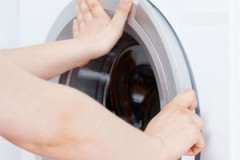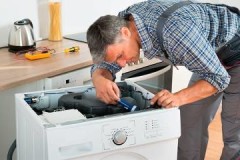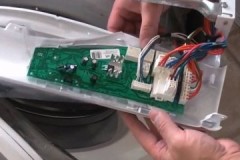Recommendations for repairing and replacing the motor of a Bosch washing machine
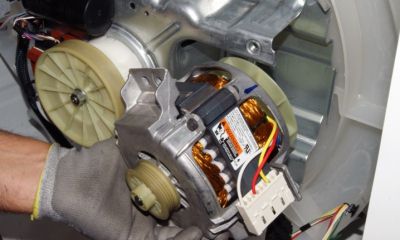 Engine malfunction is a problem that requires immediate attention. After all, the motor is the “power” of a household appliance, the “rod” without which it is impossible to start the washing process.
Engine malfunction is a problem that requires immediate attention. After all, the motor is the “power” of a household appliance, the “rod” without which it is impossible to start the washing process.
Having basic knowledge of the internal structure of a washing machine and strictly following the prescribed algorithm of actions, you can independently eliminate the problem of a non-working motor.
Otherwise, you will have to use the services of professional craftsmen. We will tell you further how to repair the motor of a Bosch washing machine.
Content
Bosch washing machine motor design
Most models of Bosch washing machines equipped with compact but quite powerful brushed motors.
The commutator motor operates on both alternating and direct current. The brushes transmit current to the rotor, a magnetic field is formed in the winding ring, which triggers the rotation of the shaft (depending on the voltage in the network, the rotation speed may vary). Through a drive belt stretched over a pulley wheel, the shaft causes the drum to rotate.
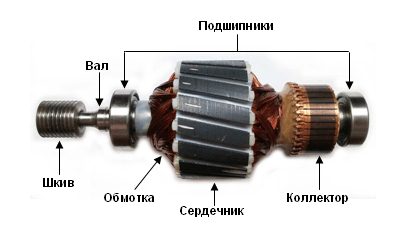 Since the 2000s, the range of Bosch washing machines has been replenished with household appliances equipped with an innovative inverter motor. This is a compact design consisting of a magnetic rotor and a cage with coils (stator).
Since the 2000s, the range of Bosch washing machines has been replenished with household appliances equipped with an innovative inverter motor. This is a compact design consisting of a magnetic rotor and a cage with coils (stator).
Unlike a commutator type motor, inverter motor is mounted directly on the drum washing machine, instead of graphite brushes, an inverter supplies current to the winding.
It is the absence of graphite brushes and a drive belt that ensures the longest period of operation of the inverter motor without repair.
You can determine the type of motor without disassembling the washing machine by the parameters of rotation speed and power (the data is indicated in the passport of the household appliance). A power of 300-800 W, a maximum speed of 15,000 rpm indicate that the washing machine is equipped with a commutator-type motor. A speed of 16,000-20,000 rpm, a power of 400-800 W indicates that the washing machine has an inverter-type motor.
How to replace?
The process of replacing (repairing) a faulty Bosch washing machine motor consists of several stages:
- Preparation,
- dismantling,
- diagnostics of a faulty unit, based on the results of which repairs are carried out or a new engine is connected.
Preparation
Before starting repair work, the washing machine must be disconnected from the electricity network (safety first) and the house’s communication systems (plumbing and sewerage). The de-energized household appliance is moved away from the walls, providing free access to any side of the washing machine body.
Removing the unit
To remove the Bosch washing machine motor, it is necessary to carry out a number of sequential actions:
 Unscrew the fasteners holding the back wall and remove the panel from the case.
Unscrew the fasteners holding the back wall and remove the panel from the case.- While rotating the pulley wheel, carefully remove the drive belt.
- Find the engine under the tank.
- Disconnect the wiring terminals from the motor.
- Using a spanner, remove the two bolts holding the motor.
- Gently rocking the motor with your hands, remove it from the washing machine body.
To avoid reconnection and reassembly errors, all dismantling actions must be recorded in photos or videos.
Diagnostics
The engine is placed on a flat, well-lit surface, after which you can begin the diagnostic procedure.
The first thing you need to do is to transfer the winding wire from the rotor to the stator, and then apply voltage. If there is no movement of the shaft, the motor requires replacement; if there is movement, the motor can be repaired.
The second stage is checking the carbon brushes. It is these small elements located on the sides of the housing that ensure the transfer of electrical energy to the rotor winding of the power unit. Over time, the brushes wear out and, as a result, not receiving enough energy, the motor stops rotating.
You can determine the length of the brush as follows:
- disconnect the wire from the brush case;
- move the contact;
- stretch the spring;
- pull out the brush.
The third stage - diagnostics of lamellas (metal plates that transmit electricity to the rotor). The lamellas are fixed on the motor shaft. During operation of the washing machine, the lamellas begin to peel off, thereby blocking the very process of transmitting electricity. The slightest peeling of the lamellas is a signal to replace the motor.
The fourth stage is winding testing.To do this, switch the multimeter to the “Resistance” mode and, applying probes to the motor shaft, analyze the result. Resistance less than 20 Ohm - signal of a short circuit, more than 200 Ohm - a winding break has occurred. A break or short circuit is a direct indication for replacing the washing machine motor.
Repair and rewinding of the electric motor of a Bosch washing machine - in the video:
How to repair?
You can repair the engine yourself, provided that the problem is not caused by a short circuit, broken winding or peeling of the lamellas. Most often, restoring the performance of the motor occurs by replacing the carbon brushes.
Algorithm of actions:
- Unscrew the fasteners holding the brushes.
- Clean the seat from dust and dirt.
- Install new elements in the prepared place.
Brushes on a washing machine are replaced only in pairs. New elements are selected according to the engine serial number.
Connecting a new part
Installing a new motor with your own hands will not be difficult if strictly adhere to a certain sequence of actions:
 We insert the engine precisely selected in terms of power, mounting shape and other technical parameters with bushings into the seats, and fix the housing with fasteners.
We insert the engine precisely selected in terms of power, mounting shape and other technical parameters with bushings into the seats, and fix the housing with fasteners.- We connect the wiring of the power unit (photos or video notes taken earlier will come to the rescue).
- While turning the pulley wheel, carefully tighten the drive belt.
- We install the back panel in its original place and secure it with the mounting bolts.
After the washing machine body is assembled, the device is connected to communications, the power cord is inserted into the socket, and a test wash is started.
Where to buy and at what price?
The quality of operation of the washing machine after repair directly depends on which motor will be installed. In order not to make a mistake with the choice, Before going to the store, you need to find out the following information:
- motor serial number,
- Name,
- model,
- number and year of manufacture of the washing machine.
It is better to buy a motor for a washing machine in stores that specialize in spare parts for Bosch household appliances. It would also be a good idea to study reviews about the selected seller (store) in advance.
This approach minimizes the risks of buying counterfeits and low-quality engines. The price of a Bosch washing machine motor varies between 2000-4500 rubles.
Call the master
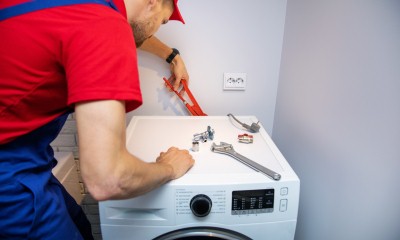 Lack of desire, time, experience or knowledge associated with repairing or replacing the engine of Bosch washing machines is a reason to use the services of service center specialists.
Lack of desire, time, experience or knowledge associated with repairing or replacing the engine of Bosch washing machines is a reason to use the services of service center specialists.
The necessary contacts can be found in the passport of the household appliance. (often listed on the last page), find out from acquaintances, friends, or find them through search engines on the Internet.
When submitting an application, the manager must be informed of the essence of the problem, the model name, serial number and year of manufacture of the washing machine.
On average, replacing a motor will cost the client 3,500 rubles. Diagnostics are free, a new power unit is paid separately. Full payment for the repairs carried out is possible only after running a test wash!
Conclusion
Understanding the motor structure and experience in repairing power units of a washing machine allows you to independently restore the functionality of household appliances.Lack of minimal knowledge of engine repair or replacement is a reason to seek help from specialists.
